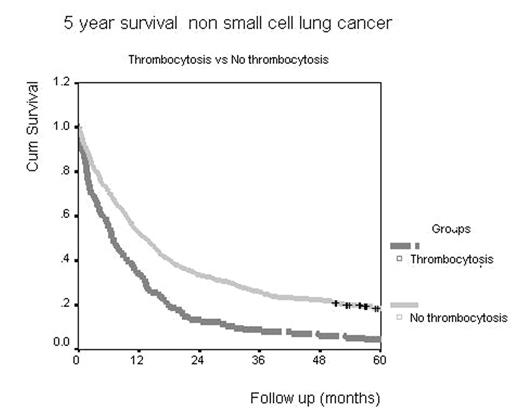Abstract
Non small cell lung carcinoma (NSCLC) is the most common cause of cancer related death in US. During its clinical course patients may develop paraneoplastic syndromes such as thrombocytosis, which has been found in 17–21% patients with lung cancer. Thrombocytosis is associated with extensive disease and a poor prognosis. The objective of this study was to characterize the prognostic value of thrombocytosis in patients with NSCLC.
A retrospective study of inpatient and outpatient medical records at a large, midwestern, urban medical center was performed. Medical records from patients containing a new diagnosis of non small cell lung carcinoma based on ICD-9 codes from 1994 to 2000 were reviewed. Patients with a prior history of malignancy, less than 6 months of follow-up, or without an assessment of their platelet count were excluded. All records were reviewed for the following: TNM stage, histologic type by WHO criteria, and survival. Laboratory data was obtained prior to invasive diagnostic procedures, and thrombocytosis was defined as a platelet count > 400 K/uL. Survival was calculated by Kaplan Meier curves and the difference in survival curves was tested by log rank test.
Thrombocytosis was observed in 113/858 patients (13.2 %). The group with thrombocytosis in comparison with the group without thrombocytosis had a significantly lower mean age at diagnosis (63 y vs 67 y, p<0.001), hemoglobin (11.6 mg/dl vs 13.0 mg/dl, p<0.001) and advanced stages were more frequent, TNM III and IV (79.8% vs 66.2%, p=0.007). No difference was observed between histologic types. 5 year survival was lower in patients with thrombocytosis (4% vs 18%, p <0.001).
Thrombocytosis in patient with non small cell lung carcinoma is associated with advanced stages of the disease and poor survival.
5 Year survival non smell cell lung cancer
Author notes
Corresponding author


